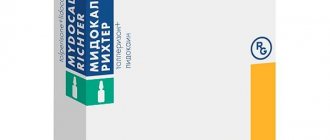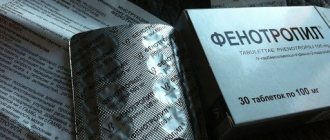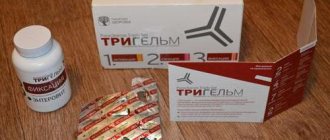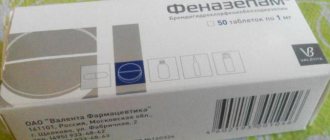Mexidol is a drug that has the properties of an antioxidant, membrane protector, nootropic and anticonvulsant. The medicine relieves tissue hypoxia, feelings of fear, moderately corrects dopamine synthesis, and acts as a stress protector: it calms, minimizes motor excitation, and relaxes skeletal muscles.
At the same time, Mexidol balances metabolism, microcirculation, stimulates cerebral blood flow, and improves the rheological properties of blood. According to the instructions for use, Mexidol helps with neurological disorders, VSD, atherosclerosis, ischemic heart disease, asthenia, withdrawal syndrome, encephalopathy of various origins, and mild brain injuries.
Release form, composition and packaging
Mexidol is available in tablets and ampoule versions for intravenous and intramuscular administration. The composition of the drug remains unchanged: the base is ethylmethylhydroxypyridine succinate. For Mexidol tablets - 125 mg of active substance, for injection solution - 50 mg.
Excipients: lactose monohydrate from milk (97.5 mg), povidone - iodine-based antiseptic (25 mg), magnesium stearate - food additive (2.5 mg). The shell contains substances that protect the gastric mucosa from irritation and ensure optimal absorption of the drug in the intestine.
Mexidol ampoules, in addition to the active substance, contain water and sodium metabisulfite.
Tablets are available in packages of 10 - 50 pieces, ampoules for injection - 1, 2, 5, 10 ml from 5 to 15 pieces.
Adverse reactions
While taking Mexidol (international name in Latin Mexidol), some undesirable reactions may occur, including:
If these symptoms appear, you do not need to stop taking the drug. Adverse reactions will go away on their own and will not require specific additional treatment. To eliminate the metallic taste in the mouth during intravenous administration of Mexidol (international name in Latin Mexidol), it is necessary to reduce the rate of administration of the drug.
pharmachologic effect
The medicine increases resistance to stress and counteracts cell destruction under the influence of ischemia and hypoxia. According to the instructions, Mexidol relieves acute conditions - shock, stroke, alcohol poisoning, overdose of neuroleptics, antipsychotics, and also gently relieves regional vasospasm, seizures, and panic attacks.
The mechanism of action of the drug is based on improving microcirculation and regional blood flow of internal organs, primarily the brain, adjusting blood viscosity, stabilizing the membranes of blood cells during hemolysis.
In addition, the drug balances lipid metabolism, that is, it resists atherosclerosis, reducing LDL, and can minimize endogenous intoxication when the enzymatic activity of the pancreas is disrupted.
Thus, Mexidol controls the enzymatic activity of redox processes in the body, GABA complexes, acts as a neurotransmitter, stimulates synaptic transmissions, takes part in the Krebs cycle, increasing the activity of ATP, creatine phosphate, and cellular mitochondria. All this makes it possible for Mexidol to streamline the metabolism of the heart muscle, minimize the area of necrosis in case of ischemia, improve the electrical activity of the myocardium, its contractile function, increase coronary blood flow, minimizing the destruction of the heart muscle.
Mexidol potentiates the effect of nitrates in ischemic heart disease, preserves retinal ganglion cells, optic nerve, stops the progression of neuropathy, and restores visual acuity.
Brief description of the drug
"Mexidol" refers to antioxidant agents used to improve blood supply and metabolic processes in the brain.
Release forms: injection solution and tablets for oral use. The development of the drug began in the 80s of the twentieth century. In 2003, its creators received a prize from the Government of the Russian Federation for synthesizing and introducing the drug into medical practice. The drug soon gained recognition among drugs in the field of neurology, surgery and narcology. It has a wide range of indications for use: from vegetative-vascular dystonia to ischemic cerebral circulatory disorders .
When is the product used?
The drug "Mexidol" is recommended for the treatment of ischemic circulatory disorders in the brain, vegetative-vascular and neurocirculatory dystonia, and cerebral dysfunction of atherosclerotic origin. The medicine is prescribed for various pathologies of the neurotic spectrum, neurosis-like personality changes, generalized anxiety disorders, to relieve intoxication with antipsychotic drugs, and for withdrawal symptoms.
This medication is also used in the treatment of acute inflammatory diseases of the peritoneum, pancreatic necrosis, peritonitis, conditions accompanied by tissue hypoxia, as well as pathologies such as epilepsy, Alzheimer's disease and parkinsonism.
How does the medicine affect the course of the disease?
The main difference in the pharmacodynamics of the drug from traditional neurotropic drugs is the lack of specific binding to receptors. "Mexidol" acts as an inhibitor of free radical processes, has protective properties against cell membranes, as well as antihypoxic, anticonvulsant and anxiolytic effects. The drug helps to increase the resistance of body systems in response to shock destabilization, increases resistance to ischemia, hypoxia, microcirculation disorders, and ethanol intoxication. The drug affects the activity of membrane-bound enzymes (adenylate cyclase, phosphodiesterase, acetylcholinesterase) and receptor complexes (benzodiazepine, GABA, acetylcholine), as a result of which their ability to bind to ligands increases. Mexidol preserves the structural and functional organization of cell membranes and improves the transmission of information in synaptic clefts.
In addition, the drug increases the amount of dopamine in the medulla, which in turn leads to activation of glycolysis and slowdown of redox reactions in the tricarbonic acid cycle. As a result, the level of creatine phosphate and ATP in mitochondria increases.
The medicine exhibits an anti-stress effect, which is realized in the normalization of behavior, improvement of sleep cycles, helps restore memory and learning processes, and reduces degenerative changes in brain structures.
When taking Mexidol and sedatives, neuroleptics, antidepressants, hypnotics, and anticonvulsants simultaneously, the effect of both drugs increases, which requires adjustment of the doses of the latter in order to reduce side effects.
Mexidol also has an analgesic effect. This effect is achieved due to a decrease in the sensitivity threshold. The medicine has anti-inflammatory properties, which are aimed at protecting the cellular structures of the body (including the brain) from the harmful effects of toxins and other harmful substances.
Features of use for vegetative-vascular dystonia
The medication should not be prescribed to patients with hypersensitivity to the active substance, acute kidney and liver diseases. It is not recommended to take the medicine for pregnant and nursing mothers. Also, you should not use the drug if you are allergic to vitamin B6.
As can be seen from the above, Mexidol is low-toxic and does not have many side effects, which means that the drug is safe for almost all groups of patients.
Indications for use
- ONMK;
- AMI;
- consequences of brain injuries;
- encephalopathy of various origins;
- VSD;
- impairment of memory, cognitive functions;
- neuroses, anxiety states;
- primary open-angle glaucoma of any stage (as part of a complex of drugs);
- withdrawal syndrome;
- drug intoxication (psychotropics);
- inflammation of the abdominal cavity with secondary infection, suppuration - as part of a combination treatment.
Dosage regimen
According to the instructions for use, acute conditions are treated with Mexidol solution, which is administered intravenously, in a dropper or intramuscularly. Infusion of the drug involves diluting the drug in a 0.9% sodium chloride solution. In a dropper, with a jet injection, the medicine is transported into the blood within 5-7 minutes, dripping at a speed of one drop/second. The daily maximum of the product is 1.2 g.
How to take Mexidol is described in detail in the instructions for the drug. At:
- For the first two weeks (10 days), Mexidol is injected intravenously at 200 or 500 mg two to four times a day, the remaining time (14 days) - 200 or 250 mg three times a day.
- Traumatic brain injury involves using the drug for 10 to 15 days, 200 or 500 mg drips two to four times a day.
- VSD in the stage of decompensation requires jet or drip administration of Mexidol 200-500 mg 1-2 times a day for a couple of weeks, then for two weeks they switch to intramuscular administration of the drug 100-250 mg/day. For prevention, intramuscular injections of the drug 200-250 mg twice a day for a couple of weeks (sometimes 10 days) are sufficient.
- Cognitive impairment is relieved by intramuscular administration of the drug at a dose of 100-300 mg for a month (sometimes two weeks).
- AMI - Mexidol is injected into a vein or muscle for two weeks in a row against the background of traditional treatment of a heart attack, which includes nitrates, thrombolytics, antihypertensive drugs, anticoagulants, antiplatelet agents, and symptomatic drugs according to indications. For the first 5 days, it is preferable to administer drugs into a vein, then into a muscle for 9 days. The daily maximum of the drug is 800 mg, one-time - 250 mg.
- Open-angle glaucoma allows the use of Mexidol tablets as part of complex therapy at 100-300 mg/day, 1-3 times for two weeks.
- Withdrawal syndrome requires drip or intramuscular administration of 200-500 mg of the drug 2-3 times a day for a week.
- Acute poisoning (intoxication) with drugs – 200-500 mg/day, two weeks.
- Peritonitis, acute pancreatitis with necrosis, and other purulent processes of the abdominal cavity in dosage are correlated with the severity of the patient under the control of laboratory data, but Mexidol is used both before and after surgery. Acute pancreatitis with edema involves the administration of Mexidol injections of 200-500 mg three times a day, dropwise or into a muscle. Mild degree of pancreas necrosis - 100-200 mg, moderate severity - 200 mg, severe - 200-500 mg twice a day with a gradual reduction in the daily dose, extremely severe stage - from 800 mg / day until persistent relief of symptoms, after stabilization - 300-500 mg twice a day dropwise with a gradual reduction in the daily dose.
Mexidol tablets are used for the chronic course of a particular pathology or for its prevention.
Mexidol for VSD
The autonomic nervous system is responsible for regulating the functioning of internal organs. It consists of 2 departments: sympathetic and parasympathetic. The sympathetic nervous system increases blood pressure, increases heart rate, and reduces the activity of the digestive tract. The parasympathetic system has the opposite functions - slowing down the heart rate, lowering blood pressure, stimulating the gastrointestinal tract. Normally, both of these departments are in balance; if one predominates, then only slightly.
Against the background of stress, overwork, and psychological experiences, the balance between the sympathetic and parasympathetic systems is disrupted. A condition develops that is called vegetative-vascular dystonia (VSD). Depending on the prevailing symptoms, there are several options:
- hypertensive type (with increased blood pressure);
- hypotonic type (with a decrease in pressure);
- cardiac type (with heart rhythm disturbances);
- mixed type (combination of several symptoms).
Doctors about the drug Mexidol
The drug as monotherapy gives unstable results, but at the same time it acts quickly and is well tolerated. Mexidol is more effective when administered parenterally as part of complex measures. The active substance Mexidol combines well with other medications, making it the drug of choice for the treatment of acute conditions.
What else is Mexidol used for? The drug is indicated for vertigo, vascular pathologies, and during the rehabilitation period after acute ischemia and hypoxia.
Contraindications
Mexidol is not prescribed in the following situations:
Severe liver dysfunction may also be a reason to limit Mexidol intake. The trade and international name of the drug has already been discussed, so we can move on to other, no less important issues.









